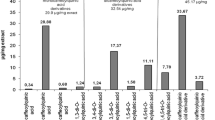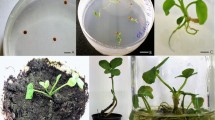Abstract
Leonurus sibiricus L. is a traditional medicinal plant which occurs in southern Siberia, China, Korea, Japan, and Vietnam. The plant shows several pharmacological effects, but the most interesting is its anti-cancer activity. The aim of our study was to examine the induction of apoptosis in malignant glioma cells, the most aggressive primary brain tumors of the central nervous system, following treatment with transformed root (TR) or non-transformed root (NR) L. sibiricus extracts. Both the NR and TR extracts were found to have cytotoxic activity in the glioma primary cells. The human glioblastoma cell lines obtained from patients were confirmed to be tumorogenic by the following three markers: D10S1709, D10S1172, and D22S283. HPLC and MS analysis revealed the presence of polyphenolic compounds (chlorogenic acid, ferulic acid, caffeic acid, p-coumaric acid, ellagic acid, and verbascoside) in both sets of root extracts. In summary, our findings demonstrate that treatment of the glioma cells with NR and TR extracts resulted (a) in significant cell growth inhibition, (b) S- and G2/M-phase cell cycle arrest, and (c) apoptosis in a dose-dependent fashion by changing Bax/Bcl-2 ratio (about 4-fold increase) and p53 (5-fold increase) activation. These findings indicate that NR and TR extracts exhibit anti-cancer activity through the regulation of genes involved in apoptosis. This is the first report to demonstrate the cytotoxic effect of polyphenolic extracts from L. sibiricus roots against glioma cells, but further studies are required to understand the complete mechanism of its apoptosic activity.







Similar content being viewed by others
References
Jovčevska I, Kočevar N. Glioma and glioblastoma—how much do we (not) know? Mol Clin Oncol. 2013;1:935–41.
Gurney JG, Kadan-Lottick N. Brain and other central nervous system tumors: rates, trends, and epidemiology. Curr Opin Oncol. 2001;13:160–6.
Wrensch M, Minn Y. Epidemiology of primary brain tumors: current concepts and review of the literature. Neuro Oncol. 2002;4:278–99.
Stupp R, Mason WP, van den Bent MJ, Weller M, Fisher B. Radiotherapy plus concomitant and adjuvant temozolomide for glioblastoma. N Engl J Med. 2005;352:987–96.
Gerstner ER, Duda DG, di Tomaso E, Sorensen G, Jain RK, Batchelor TT. Antiangiogenic agents for the treatment of glioblastoma. Expert Opin Investig Drugs. 2007;16:1895–908.
Ahmed F, Islam MA, Rahman MM. Antibacterial activity of Leonurus sibiricus aerial parts. Fitoterapia. 2006;77:316–7.
Shin HY, Kim H, Kang SM, Chang IJ, Kim SY, Jeon H, et al. Anti-inflammatory activity of motherwort (Leonurus sibiricus L.). Immunopharm Immunot. 2009;31:209–13.
Lee MJ, Lee HS, Park SD, Moon HI, Park WH. Leonurus sibiricus herb extract suppresses oxidative stress and ameliorates hypercholesterolemia in C57BL/6 mice and TNF-alpha induced expression of adhesion molecules and lectin-like oxidized LDL receptor-1 in human umbilical vein endothelial cells. Biosci Biotechnol Biochem. 2010;74:279–84.
Chinwala MG, Gao M, Dai J, Shao J. In vitro anticancer activities of Leonurus heterophyllus sweet (Chinese motherwort herb). J Altern Complement Med. 2003;9:511–8.
Mazzio EA, Soliman KF. In vitro screening for the tumoricidal properties of international medicinal herbs. Phytother Res. 2009;23(3):385–98. doi:10.1002/ptr.2636.
Rodríguez M, Estrela JM, Ortega AL. Natural polyphenols and apoptosis induction in cancer therapy. J Carcinog Mutagen. 2013;S6:004. doi:10.4172/2157-2518.S6-004.
Murashige T, Skoog F. A revised medium for rapid growth and bioassays with tobacco tissue cultures. Physiol Plant. 1962;15:473–97.
Vervliet G, Holsters M, Teuchy H, Van Montagu M, Schell J. Characterization of different plaque-forming and defective temperate phages in Agrobacterium strains. J Gen Virol. 1975;26:33–48.
Schenk RU, Hildebrandt AC. Medium and techniques for induction of growth of monocotyledonous and dicotyledonous plant cell cultures. Can J Bot. 1972;50:199–204.
Skała E, Kicel A, Olszewska MA, Kiss AK, Wysokińska H. Establishment of hairy root cultures of Rhaponticum carthamoides (Willd.) Iljin for the production of biomass and caffeic acid derivatives. BioMed Res Int. 2015;181098:1–11.
Sitarek P, Skała E, Wysokińska H, Wielanek M, Szemraj J, Toma M, et al. The effect of Leonurus sibiricus plant extracts on stimulating repair and protective activity against oxidative DNA damage in CHO cells and content of phenolic compounds. Oxid Med Cell Longev. 2015.
Kleihues P, Louis DN, Scheithauer BW, Rorke LB, Reifenberger G, Burger PC, et al. The WHO classification of tumors of the nervous system. J Neuropathol Exp Neurol. 2002;215–25. discussion 226–9.
Laigle-Donadey F, Crinie’re E, Benouaich A, Lesueur E, Mokhtari K, Hoang-Xuan K, et al. Loss of 22q chromosome is related to glioma progression and loss of 10q. J Neuro-Oncol. 2006;76:265–8. doi:10.1007/s11060-005-7019-2.
Mosmann T. Rapid colorimetric assay for cellular growth and survival: application to proliferation and cytotoxicity assays. J Immunol Methods. 1983;65:55–63.
Herrmann M, Lorenz HM, Voll R, Grunke M, Woith W, Kalden JR. A rapid and simple method for the isolation of apoptotic DNA fragments. Nucleic Acids Res. 1994;22(24):5506–7.
Taehakkyo S, Yŏn’guso S. Medicinal plants in the Republic of Korea, Western Pacific series No. 21. World Health Organization, Regional Office for the Western Pacific. 1998.
Chen L, Han L, Shi Z. LY294002 enhances cytotoxicity of temozolomide in glioma by down-regulation of the PI3K/Akt pathway. Mol Med Report. 2012;5:575–9.
Darefsky AS, King JT, Dubrow R. Adult glioblastoma multiforme survival in the temozolomide era: a population-based analysis of surveillance. Epidemiol End Results Registries Cancer. 2012;118:2163–72.
Tao J, Zhang P, Liu G, Yan H, Bu X, Zhongjun M, et al. Cytotoxicity of Chinese motherwort (YiMuCao) aqueous ethanol extract is non-apoptotic and estrogen receptor independent on human breast cancer cells. J Ethnopharmacol. 2009;234–239.
Shi M, Cai Q, Yao L, Mao Y, Ming Y, Ouyang G. Antiproliferation and apoptosis induced by curcumin in human ovarian cancer cells. Cell Biol Int. 2006;30:221–6.
Murthy HN, Dijkstra C, Anthony P, White DA, Davey MR, Paek KY. Establishment of Withania somnifera hairy root cultures for the production of withanolide A. J Integr Plant Biol. 2008;50(8):975–81. doi:10.1111/j.1744-7909.2008.00680.x.
Obrenovich ME, Nair NG, Beyaz A, Aliev G, Reddy VP. The role of polyphenolic antioxidants in health, disease, and aging. Rejuvenation Res. 2010;13:631–43.
Stoner GD, Mukhtar H. Polyphenols as cancer chemopreventive agents. J Cell Biochem Suppl. 1995;22:169–80.
Jang M, Cai L, Udeani GO, Slowing KV, Thomas CF. Cancer chemopreventive activity of resveratrol, a natural product derived from grapes. Science. 1997;275:218–20.
Kang NJ, Shin SH, Lee HJ, Lee KW. Polyphenols as small molecular inhibitors of signaling cascades in carcinogenesis. Pharmacol Ther. 2011;130:310–24.
Giovannini C, Masella R. Role of polyphenols in cell death control. Nutr Neurosci. 2012;15:134–49.
Huang WY, Cai YZ, Zhang Y. Natural phenolic compounds from medicinal herbs and dietary plants: potential use for cancer prevention. Nutr Cancer. 2010;62:1–20.
Yang JS, Che-Wei L, Yi-Shih M, Shu-Wen W, Nou-Ying T, Shin-Hwar W, et al. Chlorogenic acid induces apoptotic cell death in U937 leukemia cells through caspase and mitochondria-dependent pathways. In Vivo. 2012;26:971–8.
Chang WC, Hsieh CH, Hsiao MW, Lin WC, Hung YC, Ye JC. Caffeic acid induces apoptosis in human cervical cancer cells through the mitochondrial pathway. Taiwan J Obstet Gynecol. 2010;49(4):419–24.
Zhang YJ, Nagao T, Tanaka T, Yang CR, Okabe H, Kouno I. Antiproliferative activity of the main constituents from Phyllanthus emblica. Biol Pharm Bull. 2004;27:251–5.
Ouyang L, Shi Z, Zhao S, Wang FT, Zhou TT. Programmed cel death pathways in cancer: a review of apoptosis, autophagy and programmed necrosis. Cell Prolif. 2012;45:487–98.
Donovan M, Cotter TG. Control of mitochondrial integrity by Bcl-2 family members and caspase-independent cell death. Biochim Biophys Acta. 2004;1644:133–47.
Salomons GS, Brady HJ, Verwijs-Janssen M, Van JD, Hart AA, Van H. The Bax alpha:Bcl-2 ratio modulates the response to dexamethasone in leukaemic cells and is highly variable in childhood acute leukaemia. Int J Cancer. 1997;71:959–65.
Roset R, Ortet L, Gil-Gomez G. Role of Bcl-2 family members on apoptosis: what we have learned from knock-out mice. Front Biosci. 2007;12:4722–30.
Ling YH, Liebes L, Ng B, Buckley M, Elliott PJ, Adams J. PS-341, a novel proteasome inhibitor, induces Bcl-2 phosphorylation and cleavage in association with G2-M phase arrest and apoptosis. Mol Cancer Ther. 2002;1:841–9.
D’Archivio M, Santangelo C, Scazzocchio B, Varì R, Filesi C. Modulatory effects of polyphenols on apoptosis induction: relevance for cancer prevention. Int J Mol Sci. 2008;9:213–28.
Lavin MF, Gueven N. The complexity of p53 stabilization and activation. Cell Death Differ. 2006;13:941–50.
Vaz JA, Ferreira IC, Tavares C, Almeida GM, Martins A. Suillus collinitus methanolic extract increases p53 expression and causes cell cycle arrest and apoptosis in a breast cancer cell line. Food Chem. 2012;135:596–602.
Lee YJ, Kuo HC, Chu CY, Wang CJ, Lin WC, Tseng TH. Involvement of tumor suppressor protein p53 and p38 MAKP in caffeic acid phenethyl ester-induced apoptosis of C6 glioma cells. Biochem Pharmacol. 2003;66:2281–9.
Author information
Authors and Affiliations
Corresponding author
Ethics declarations
Conflicts of interest
None
Rights and permissions
About this article
Cite this article
Sitarek, P., Skała, E., Toma, M. et al. A preliminary study of apoptosis induction in glioma cells via alteration of the Bax/Bcl-2-p53 axis by transformed and non-transformed root extracts of Leonurus sibiricus L.. Tumor Biol. 37, 8753–8764 (2016). https://doi.org/10.1007/s13277-015-4714-2
Received:
Accepted:
Published:
Issue Date:
DOI: https://doi.org/10.1007/s13277-015-4714-2




